Editor's Note: The challenges our cities face are growing, but so is the strength of this movement. Every story we share, every idea we spread, and every tool we build exists because people like you are committed to showing up. Your membership isn’t passive—it’s the momentum that makes change possible.
What is the Trick-or-Treat Test?
The trick-or-treat-test is a rule of thumb that says that a neighborhood that is inviting for trick-or-treaters is likely to have good urban design. Places that pass the trick-or-treat test have walkable, safe, connected streets, and closely-spaced homes that frame the street and are welcoming to passers-by.
The Slow, Sad Decline of Trick-or-Treating
Trick-or-treating, a beloved Halloween tradition, has been on a long, slow decline in America. While millions of kids still pound the pavement in creepy costumes in search of candy nirvana, many have turned to alternative traditions such as trunk or treat. Fear on parents' part seems to drive this shift—and by far the biggest such fear is the fear of cars.
"Here’s why Halloween is the deadliest day of the year for child pedestrians," proclaims the Washington Post, observing that children are 3 times more likely to be fatally injured by a car on the holiday than on any other day of the year.
It's worth pointing out that the Post's headline is misleading at best. The thing is, there are vastly more child pedestrians on Halloween than any other night of the year. If there are 20 times as many kids out walking, but only 3 times as many crashes, a more accurate conclusion would be that if you want to take a walk around after dark with your kid, then Halloween just may be the absolute safest night of the year to do so. There's safety in numbers after all.
But it is certainly still true that many parents have a justified fear of cars. A walkable neighborhood—one that slows all traffic down to safe speeds—is a must for great trick-or-treating. But when we look at neighborhoods that really reach the next level of Halloween glory, it's about a lot more than just street safety.
What's the Secret to That One Neighborhood That Bucks The Trend?
You know the one. The one where people count the night's trick-or-treaters by the hundreds, not the dozens—and not just local kids, but some whose parents drive them to another part of town to go door-to-door. The rumors spread across town through parents' social circles: That One neighborhood is the place to go on Halloween.
In Orlando, Florida, for example, that one neighborhood is Baldwin Park, a New Urbanist enclave carved out of the site of a former military base. I wrote about Baldwin Park for Strong Towns and mentioned its trick-or-treat appeal, including this quote from a CNU profile of the neighborhood:
Community life is active with holiday parades, porch sales, outdoor concerts and events. Halloweens are “crazy,” Grandin says, with each house getting 150 to 200 trick-or-treaters—some of whom come from other parts of the city. “People in Baldwin Park really do sit on porches and chat and talk and walk. I know everybody on my block and I’ve been there only 2 years. People make a point of introducing themselves.”
Anecdotally, many cities seem to have a neighborhood or two like this, and very often those neighborhoods have similar physical characteristics, not just demographic ones.
It turns out the spookiest night of the year has a whole lot to teach us about the spooky wisdom of traditional urbanism—the techniques we've inherited from past generations for building places that bring out the best in humanity.
These lessons amount to a set of rules of thumb called the trick-or-treat test. Versions of it have circulated in urban planning and design circles for years. It was perhaps made most famous in a 2012 CityLab article by Brent Toderian, the former planning director for the city of Vancouver, BC. Here's our take on the trick-or-treat test, which is pretty close in... ahem... spirit.... to Toderian's version.
Six Checkboxes on the Trick-or-Treat Test
Let's break down six of the urban design factors that make for A+ Halloween appeal:
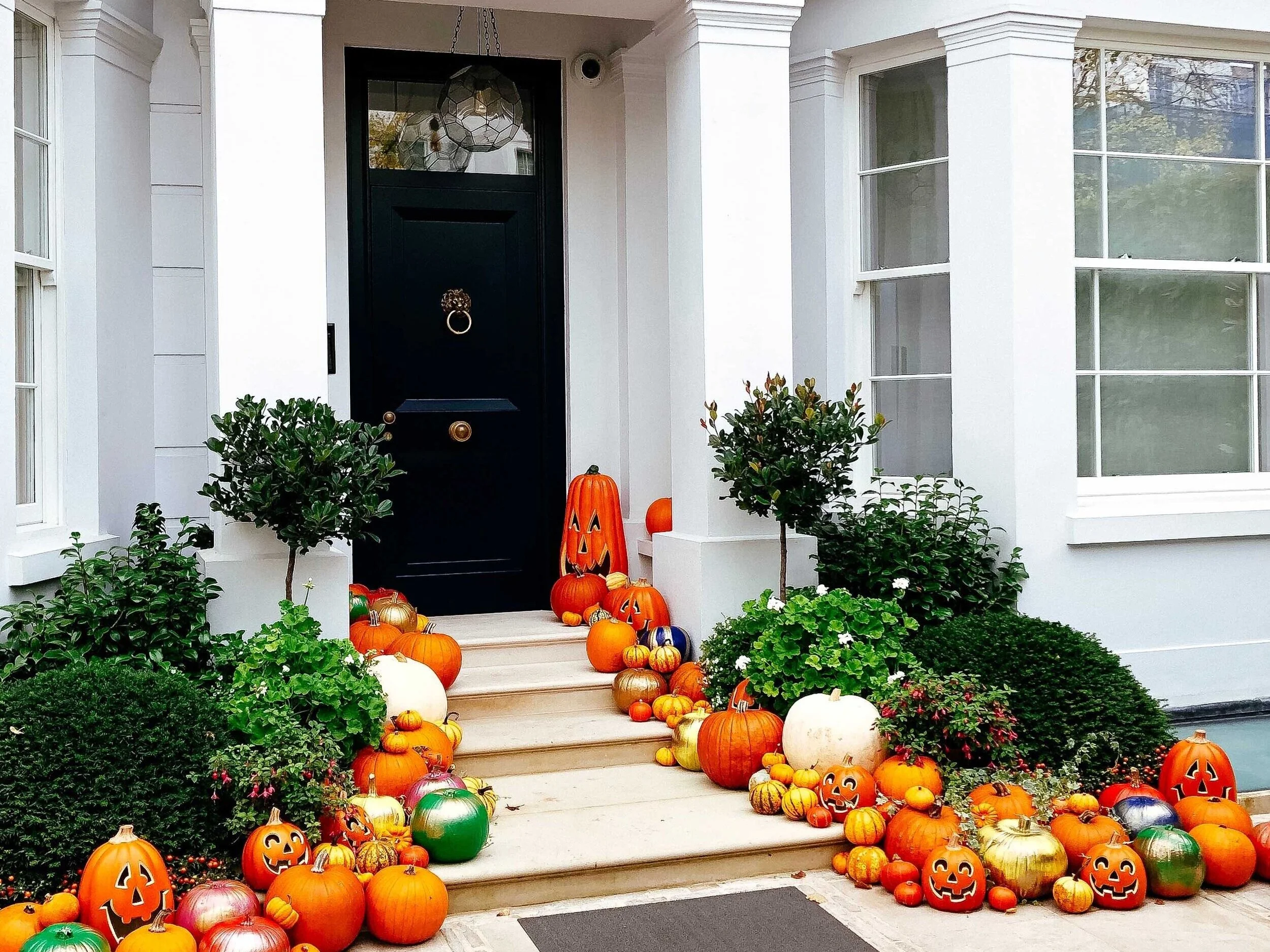
1. Lots of Doors
It’s all about that candy-per-minute ratio.
In neighborhoods with really large lots and long distances between front doors, your kids are gonna tire out fast. The best neighborhoods on a candy-per-minute basis have got to be those that score well on the Gehl Door Average—a measure of the number of front doors per 100 meters of street frontage. (And arguably the most important metric in urban design that should be in every city's zoning code, but is in virtually none of them.)
Urban planner Paul Knight even humorously quantifies the candy-grabbing potential of neighborhoods based on density in this blog post.
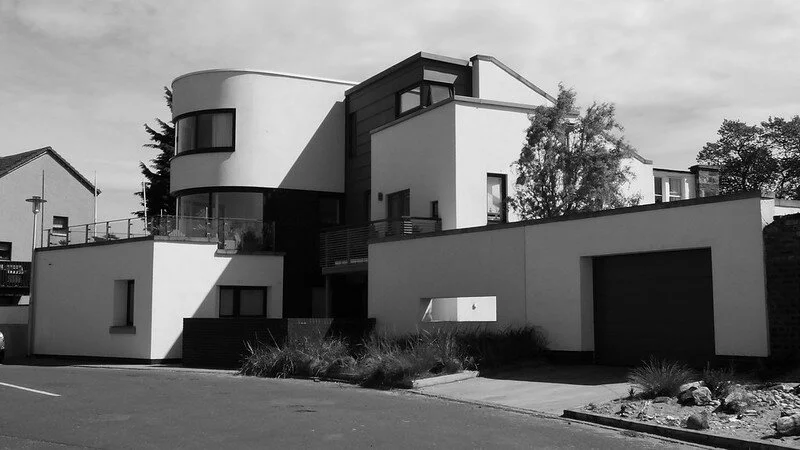
2. Doors you can find.
The “bunker” or “snout house” aesthetic isn’t so welcoming on Halloween night.
The dreaded snout house presents a less than welcoming visage to little goblins. Modernist home designs, even without the garage factor, often really obscure the entrance to the house—sort of a "bunker" approach to architecture. One of the consistent features of traditional urbanism across the decades is homes in which the front entrance is centered and prominent, both welcoming the neighborhood in and establishing the house as part of it.
You don't even need single-family houses to have a good front-door game. Big apartment complex with an impersonal lobby and a security guard? Not getting any candy there. Six-plex with a shared front porch? You just might!
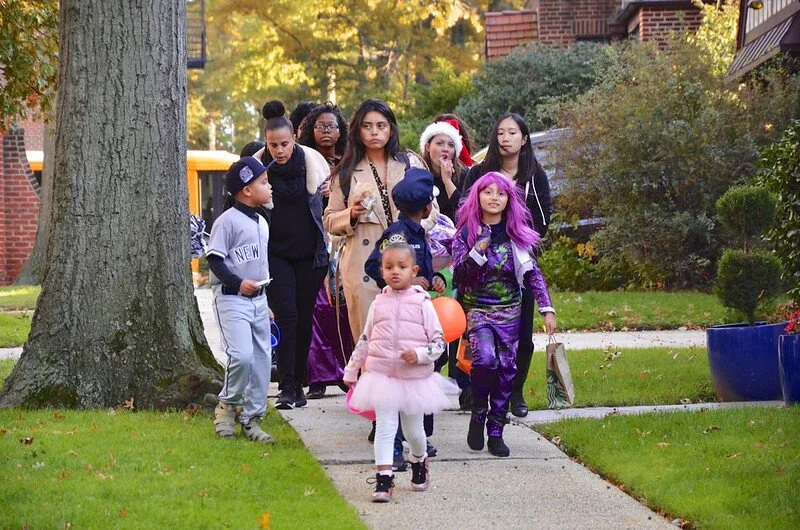
3. Comfortable sidewalks.
Or very narrow streets will do!
Comfortable sidewalks or narrow streets. An increasing number of neighborhoods, particularly newer suburban-style ones, are designed, deliberately or unintentionally, to facilitate fast traffic on residential streets—perhaps the single biggest factor in the move to trunk-or-treat is that parents simply don't feel safe walking around with their kids after dark. What if a car whips around a curve and hits someone?
Sidewalks are ideal, but narrow enough streets (I'm talking so narrow two cars can't pass each other without slowing down to a crawl) can substitute. It helps when they're tree-lined or landscaped to provide a hard visual "edge."
Here in Florida, where I live, there's an abundance of Spanish moss, which is the absolutely perfect spooky Halloween backdrop where it's draped across the entire width of a street narrow enough to allow for that.
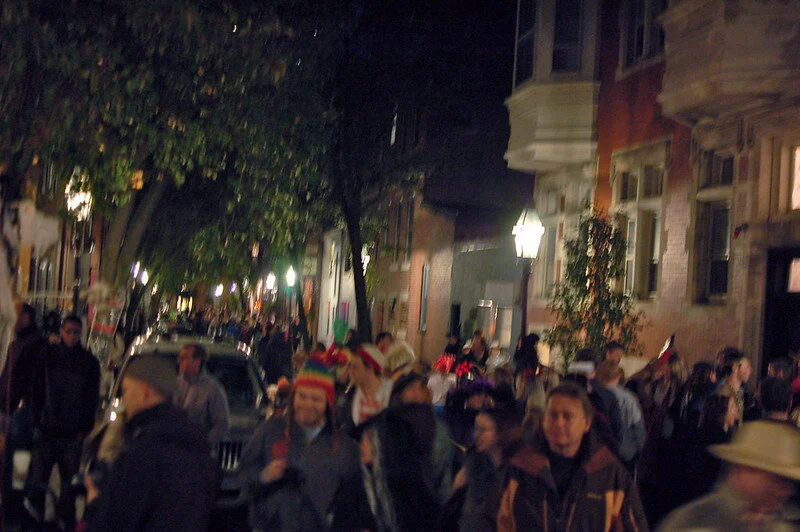
4. Small setbacks.
Buildings that frame the street make for a welcoming experience.
When buildings are placed near the street, the street begins to feel like a comfortable, welcoming outdoor room. The houses with their lights on are close enough to beckon you in as you walk by. Unfortunately, in a lot of newer neighborhoods, houses are set much farther back from the street—so far you couldn’t easily talk to someone on the front steps. This makes the sidewalk—even if attractively landscaped—into a very exposed environment that is harder to feel comfortable in or enticed to walk along.
Small setbacks are also good for eyes on the street—they facilitate a casual sort of interaction between the private realm and the public realm as people look out their windows at the goings-on outside.
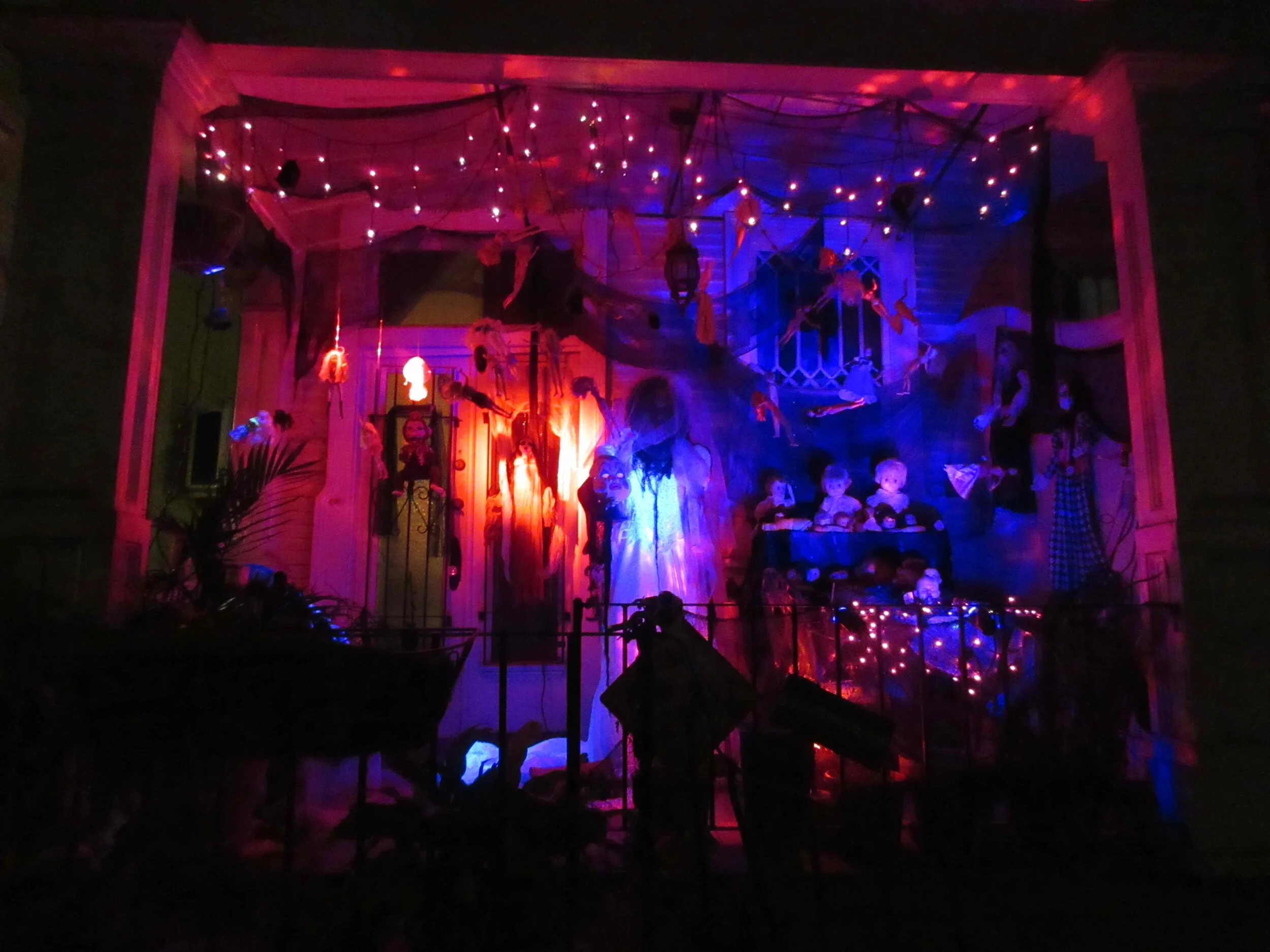
5. Porches or stoops.
This is where the action happens.
These places provide a transitional space between the public realm of the street and sidewalk, and the private realm of someone's home. These spaces are where all the Halloween action takes place, for good reason—it's a night that breaks down the barriers between neighbors, a night when you can go ring the doorbell of someone you've never spoken to otherwise. (Plus a porch is just a great stage for decorating!)
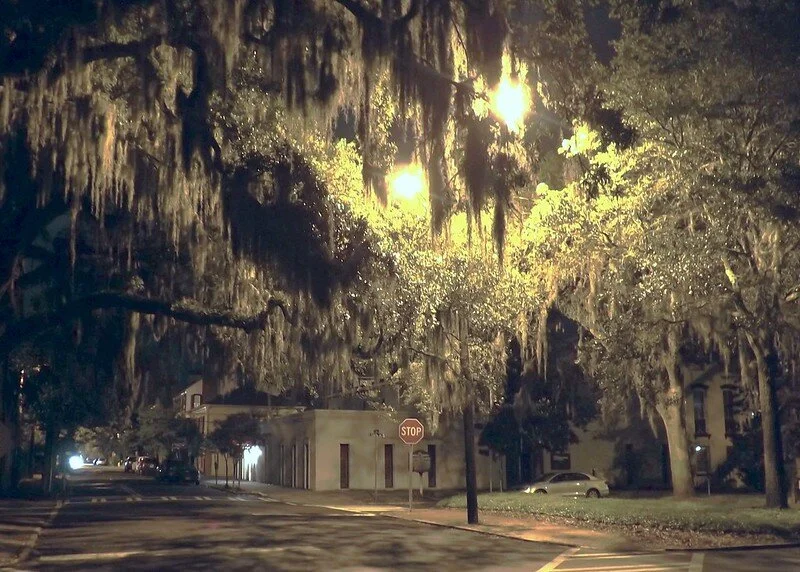
6. Well connected streets.
Minimize backtracking and getting lost.
The last thing a kid wants is to have to backtrack! That's valuable candy-collecting time wasted walking by homes you already hit up! Even worse is getting confused about whether you did this street yet or not, because you just know Mom or Dad is gonna say, of course we did, let's hurry up and get home. Neighborhoods that are all cul-de-sacs and dead-ends provide a navigational challenge; neighborhoods that are well-connected provide a seamless trick-or-treat route of any length.
It's About Pro-Social Neighborhood Design
This stuff doesn't just matter on Halloween night, is the thing. The brilliance of the Trick-or-Treat Test is that if you design a place that's especially well suited for trick-or-treating, you've almost certainly also designed a place that is well-suited for building community.
Traditional urbanism, with its small setbacks so buildings frame the street; prominent front doors; well-proportioned homes that evoke human faces; design for comfort and navigability by people on foot. These attributes aren't about such planner-y abstractions as "density" and "value per acre." They're about design that creates social trust and interaction among neighbors.
A place where you feel comfortable walking up to a neighbor's door to ask for candy one night of the year is a place where you might feel comfortable walking up to that door any other night of the year to borrow a tool, drop off a plate of cookies, let someone know about the upcoming block party, or ask what they know about the city's plans for that park down the street.
It's about serendipitous interaction. And yes, I know you can do all this via technology—neighborhood Facebook groups, NextDoor groups, and email lists are common practice, and people who've lived in very suburban environments will assure you that there's all sorts of neighborhood social life; it's just a lot of it occurs in the back yards or behind closed doors and you have to be invited in.
There's still something to be said for the serendipity that happens when neighborhood design subtly pushes us into the public realm—walking to the corner store, hanging out on a front porch instead of a back deck—where unscripted, unplanned interactions might occur, even with people who we would never talk to otherwise. That kind of interaction binds us together in the form of community solidarity and a sense of shared stewardship of the place we love.
It's the same sense that just might motivate a retiree without kids of their own at home to spend hours decorating their porch with cobwebs and skeletons to welcome a couple hundred little ghouls on one extra magical night of the year.





